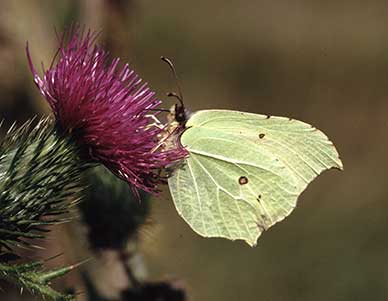New Forest butterflies - an introduction

on late summer thistles
Many people have a soft spot for butterflies, for unlike many insects they're colourfully attractive creatures that in most cases do little harm to man's interests.
Indeed, who can fail to be impressed by the first butterflies of the year, those that over-winter as adults and emerge on warm January and February days as welcome heralds of the spring?
Then in April, bright yellow brimstones and gaudy peacocks fly amongst carpets of bluebells, adding a splash of colour and contrast to the woodland greens and blues.
In July, silver-washed fritillaries fly powerfully along New Forest woodland rides, stopping every so often to gorge on nectar from the bramble blossoms, keeping company with small skippers, large skippers, gatekeepers, ringlets, meadow browns, and early, second generation brimstones.
At around the same time on the summer heaths, countless thousands of tiny silver-studded blues flit above the heather, after in their early life stages living in harmony with attendant ants. And later in that same month, graylings start to appear on the heaths before their main, slightly later, emergence.
Consider also the miracle of butterfly migration, the staggering annual journeys completed by painted ladies and clouded yellows, fragile visitors each year to Britain, insects that cross the seas from mainland Europe, and even farther afield, to grace our shores.
Yes, butterflies are fascinating, beautiful creatures that have the potential to make even the dullest heart leap, to reinforce again and again the glories of nature.
Here in the New Forest, butterfly enthusiast and casual observer alike will find much to please.
And never mind that past commercial forestry activities, misguided bramble removal programmes and access to the woodland inclosures by commoners' stock have substantially reduced numbers and variety compared to the truly outstanding days of the late 19th century, and the still-impressive years of the first half of the 20th century.

Lessons have been learnt, and in recent times forestry activities have been more sympathetic to wildlife generally and butterflies in particular, whilst a number of New Forest Keepers take a special interest in the butterflies on their patch, and manage habitats accordingly.
Today, of the sixty or so resident and regular migrant species found in Britain, almost forty occur in the New Forest. Some are widespread and abundant, others relatively scarce and unlikely to be encountered without a diligent search or a huge slice of luck.
Some are particularly associated with the heathlands, others with the broad-leaved forestry inclosures. Smaller numbers can be seen in the ancient, unenclosed woodlands, whilst even the wetter areas of valley mire attract over-flying individuals.
There are some real beauties, too, stunning creatures such as the white admiral, green hairstreak and marbled white: and a variety of rarities, or at least species that are relatively scarce in many places elsewhere. Look out in particular for those heathland silver-studded blues and in the woods for pearl-bordered fritillaries and small pearl-bordered fritillaries.
Enjoy the sight of them all, and maybe take the time to discover something of their often fascinating lives.
Find out more about New Forest butterflies
Getting started
Some notable New Forest butterflies
New Forest Insects - a photographic guide
If you have an interest in New Forest insects - butterflies, dragonflies and damselflies, beetles, bugs or just about anything else - look out for the photographic guide (published in May 2011) produced by local expert Paul Brock.
Look out, also, for Paul's new book, A Comprehensive Guide to the Insects of Britain and Ireland, which was published in spring 2014.
Quick linksMore links
Search this site

Sadly, 58 animals were killed - 35 ponies, 13 cows, 8 donkeys and 2 sheep, whilst a further 32 were injured - 3 pigs, 9 donkeys, 11 cows and 9 ponies.
(Forty-three accidents occurred in daylight, 15 at twilight and 101 in the dark. Twenty-seven accidents were not reported by the driver involved).
Here's just one horrific example - Three donkeys killed in collision with van at notorious New Forest blackspot (Advertiser and Times)
Sika deer continue to engage in rutting behaviour, and will do so until December.
Pigs seek out the remains of the acorn crop.
Beech leaves are transformed into a magnificent mosaic of glorious reds and golds. Other deciduous trees, too, take on an autumnal cloak before their leaves fall.
Dragonflies can occasionally be seen on the wing on bright days early in the month.
December
Foxglove leaves survive the winter at ground level, and offer the prospect of colourful summer blooms to come.
Redwings and fieldfares, autumn and winter visitors, gorge on haws and holly berries.
Great grey shrikes and hen harriers hunt over the heaths and other open spaces.
Honeysuckle by the end of the month often shows welcome signs of new growth.



